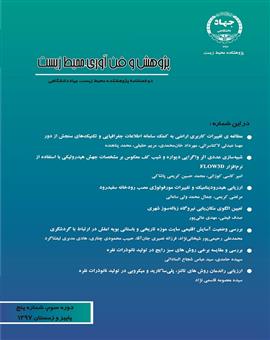ارزيابي راندمان روش هاي تالنز، پليساکاريد و میکروبی در توليد نانوذرات نقره
محورهای موضوعی : تکنولوژی آب و فاضلاب
1 - عضو هیات علمی
کلید واژه: نانوذرات نقرهپلیساکاریدتالنزمیکروبی ,
چکیده مقاله :
يکي از جنبههاي مهم کاربرد نانوفناوري، گسترش فرايندهاي پايا و سازگار با محيط زيست براي توليد نانوذرات فلزي مي باشد. از اينرو استفاده از روش هاي سبز جهت توليد نانوذرات نقره مرسوم شده است. بنابراين در اين پژوهش روش هاي سبز پليساکاريد، پلیساکارید اصلاح شده، تالنز و ميکروبي جهت توليد اين نانوذرات مورد بررسي و مقايسه قرار مي گيرد. در روش های پلی ساکارید و تالنز از نشاسته و بتا ديگلوکز به ترتيب بهعنوان پايدارکننده و احياگر استفاده شد. در روش بیولوژیکی، بیوماس و صافیده قارچ فوزاریوم اکسیسپوروم جهت سنتز نانو ذرات بکار گرفته شدند. نتایج تصاوير SEM و طيف جذب UV-vis و DLS نانوذرات ساخته شده از چهار روش بالا نشان داد که روش پليساکاريد به توليد نانوذرات با اندازه کوچکتر (20نانومتر)، پایداری بیشتر (دو ماه)، بهرهدهي بالاتر و توزیع اندازه بهتر منجر مي شود. همچنین تصویر TEM نشان دهنده آن است که شکل این ذرات کروی است.
One of the important aspects of nanotechnology application is expanding sustainable and eco-friendly procedures for synthesis of metallic nanoparticles. Therefore, the green synthesis methods become customary for synthesis of nanoparticles. In this research, green polysaccharide methods, modified polysaccharide, tollens and microbial methods were investigated. In polysaccharide and tollens methods, starch and β-D glucose were used as a satabilizer and reducer respectively. In biological method biomass and cell filtrate of the Fusarium oxysporum fungus were used for synthesis of nanoparticles. SEM images and UV-visible absorbtion spectra of these procedures showed that the polysaccharide method produced smaller silver nanoparticles (20 nm), more resistance (2 months) and higher efficiency. Also, TEM imageindicated that the shapes of these particles are spherical.
1. K. Prasad, K. J. Anal, Biosynthesis of CdS nanoparticles: An improved green and rapid procedure, Journal of Colloid and Interface Science 342 (2010) 68-72.
2. M. Gajbhiye, J. Kesharwani, A. Ingle , A. Gade, M. Rai, Fungus-mediated synthesis of silver nanoparticles and their activity against pathogenic fungi in combination with fluconazole. Nanomedicine 5 (2009) 382-386.
3. A. Khosravi, S. A. Shojaosadati, Evaluation of silver nanoparticles produced by fungus Fusarium oxysporum. International Journal of Nanotechnology 6 (2009) 973-983.
4. A. Shirinyan, M. Wautelet, On phase change in nanosystems. Materials science and engineering 26(2006) 735-738.
5. N. Saifudin , C.W. Wong, A. A. Nur yasumira, Rapid Biosynthesis of Silver Nanoparticles Using Culture Supernatant of Bacteria with Microwave Irradiation, E-Journal of Chemistry 6 (2009) 61-70.
6. A. Ahmad, P. Mukherjee, S.Senapati, Extracellular biosynthesis of silver nanoparticles using the fungus Fusarium oxysporum. Colloids and surfaces 28 (2003) 313-318.


